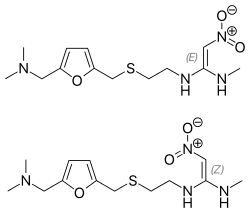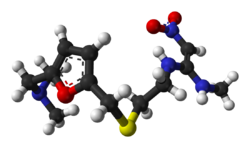User:Mr. Ibrahem/Ranitidine
 | |
 | |
| Clinical data | |
|---|---|
| Pronunciation | /rəˈnɪtɪdiːn/ |
| Trade names | Zantac[1] (original), and others |
| Other names | Dimethyl [(5-{[(2-{[1-(methylamino)-2-nitroethenyl]amino}ethyl)sulfanyl]methyl}furan-2-yl)methyl]amine, ranitidine hydrochloride (JAN JP) |
| AHFS/Drugs.com | Monograph |
| MedlinePlus | a601106 |
| License data |
|
| Pregnancy category |
|
| Routes of administration | By mouth, intravenous (IV) |
| Drug class | Histamine H2 receptor antagonist, aka H2 blocker[1] |
| Legal status | |
| Legal status | |
| Pharmacokinetic data | |
| Bioavailability | 50% (by mouth)[3] |
| Protein binding | 15% |
| Metabolism | Liver: FMOs, including FMO3; other enzymes |
| Onset of action | 55–65 minutes (150 mg dose)[4] 55–115 minutes (75 mg dose)[4] |
| Elimination half-life | 2–3 hours |
| Excretion | 30–70% kidney |
| Identifiers | |
| |
| Chemical and physical data | |
| Formula | C13H22N4O3S |
| Molar mass | 314.40 g·mol−1 |
| 3D model (JSmol) | |
| |
| |
| | |
Ranitidine, sold under the trade name Zantac among others, is a medication that decreases stomach acid production.[3] It is commonly used in treatment of peptic ulcer disease, gastroesophageal reflux disease, and Zollinger–Ellison syndrome.[3] There is also tentative evidence of benefit for hives.[6] It can be taken by mouth, by injection into a muscle, or into a vein.[3]
Common side effects include headaches, and pain or burning if given by injection.[3] Serious side effects may include liver problems, a slow heart rate, pneumonia, and the potential of masking stomach cancer.[3] It is also linked to an increased risk of Clostridium difficile colitis.[7] It is generally safe in pregnancy.[3] Ranitidine is an H2 histamine receptor antagonist that works by blocking histamine, and thus decreasing the amount of acid released by cells of the stomach.[3]
Ranitidine was discovered in England, UK in 1976, and came into commercial use in 1981.[8] It is on the World Health Organization's List of Essential Medicines.[9] It is available as a generic medication.[3] The 2015 wholesale price in the developing world was about US$0.01–0.05 per tablet.[10] In the United States it is about $0.05 per dose.[3] In 2017, it was the 48th most commonly prescribed medication in the United States, with more than 16 million prescriptions.[11][12]
In September 2019, the carcinogen N-nitrosodimethylamine (NDMA) was discovered in ranitidine products from a number of manufacturers, resulting in recalls.[13][14][15][16] In April 2020, it was withdrawn from the United States market and suspended in the European Union and in Australia due to these concerns.[17][18][19][20]
References[edit]
- ^ a b Michael Stewart, BPharm, MRPharmS (12 April 2018). "Zantac – Ranitidine to reduce stomach acid". Patient.info. Leeds, England, United Kingdom: Patient Platform Limited. Retrieved 31 March 2020.
Ranitidine reduces the amount of acid produced by your stomach. Any side-effects are usually mild and do not last long.
{{cite web}}: CS1 maint: multiple names: authors list (link) - ^ a b "Ranitidine use during pregnancy". Drugs.com. 2 December 2019. Retrieved 18 December 2019.
- ^ a b c d e f g h i j "Ranitidine hydrochloride monograph". The American Society of Health-System Pharmacists. Archived from the original on 9 September 2017. Retrieved 1 December 2015.
- ^ a b Gardner JD, Ciociola AA, Robinson M, et al. (July 2002). "Determination of the time of onset of action of ranitidine and famotidine on intra-gastric acidity". Aliment. Pharmacol. Ther. 16 (7): 1317–1326. doi:10.1046/j.1365-2036.2002.01291.x. PMID 12144582.
- ^ "Single Drug Information – International Medical Products Price Guide". Retrieved 22 August 2020.
- ^ Fedorowicz Z, van Zuuren EJ, Hu N (14 March 2012). "Histamine H2-receptor antagonists for urticaria". Cochrane Database Syst Rev (3). doi:10.1002/14651858.CD008596.pub2. PMID 22419335. CD008596.
- ^ Tleyjeh IM, Abdulhak AB, Abdulhak AA, et al. (2013). "The association between histamine 2 receptor antagonist use and Clostridium difficile infection: a systematic review and meta-analysis". PLoS ONE. 8 (3): e56498. Bibcode:2013PLoSO...856498T. doi:10.1371/journal.pone.0056498. PMC 3587620. PMID 23469173.
{{cite journal}}: CS1 maint: unflagged free DOI (link) - ^ Fischer, Janos; Ganellin, C. Robin (2006). Analogue-based Drug Discovery. John Wiley & Sons. p. 444. ISBN 9783527607495. Archived from the original on 20 December 2016.
- ^ World Health Organization (2019). World Health Organization model list of essential medicines: 21st list 2019. Geneva: World Health Organization. hdl:10665/325771. WHO/MVP/EMP/IAU/2019.06. License: CC BY-NC-SA 3.0 IGO.
- ^ "Ranitidine". International Drug Price Indicator Guide. Archived from the original on 10 May 2017. Retrieved 1 December 2015.
- ^ "The Top 300 of 2020". ClinCalc. Retrieved 8 March 2020.
- ^ "Ranitidine - Drug Usage Statistics". ClinCalc. 23 December 2019. Retrieved 7 April 2020.
- ^ "Health Canada assessing NDMA in ranitidine". Health Canada. 13 September 2019. Archived from the original on 26 September 2019. Retrieved 26 September 2019.
- ^ "Statement alerting patients and health care professionals of NDMA found in samples of ranitidine". U.S. Food and Drug Administration. 13 September 2019. Archived from the original on 26 September 2019. Retrieved 26 September 2019.
 This article incorporates text from this source, which is in the public domain.
This article incorporates text from this source, which is in the public domain.
- ^ "EMA to provide guidance on avoiding nitrosamines in human medicines". European Medicines Agency (EMA) (Press release). 13 September 2019. Retrieved 19 September 2019.
- ^ Cite error: The named reference
FDA NDMA ranitidinewas invoked but never defined (see the help page). - ^ "Questions and Answers: NDMA impurities in ranitidine (commonly known as Zantac)". U.S. Food and Drug Administration. 11 October 2019. Archived from the original on 24 October 2019. Retrieved 23 October 2019.
 This article incorporates text from this source, which is in the public domain.
This article incorporates text from this source, which is in the public domain.
- ^ "FDA Requests Removal of All Ranitidine Products (Zantac) from the Market". U.S. Food and Drug Administration (FDA) (Press release). 1 April 2020. Retrieved 1 April 2020.
 This article incorporates text from this source, which is in the public domain.
This article incorporates text from this source, which is in the public domain.
- ^ "Suspension of ranitidine medicines in the EU". European Medicines Agency (Press release). 30 April 2020. Retrieved 2 June 2020.
- ^ "Ranitidine". Therapeutic Goods Administration (TGA). 2 April 2020. Retrieved 19 July 2020.
